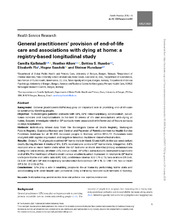| dc.contributor.author | Kjellstadli, Camilla | en_US |
| dc.contributor.author | Allore, Heather G | en_US |
| dc.contributor.author | Husebø, Bettina | en_US |
| dc.contributor.author | Flo, Elisabeth | en_US |
| dc.contributor.author | Sandvik, Hogne | en_US |
| dc.contributor.author | Hunskaar, Steinar | en_US |
| dc.date.accessioned | 2020-06-05T08:50:03Z | |
| dc.date.available | 2020-06-05T08:50:03Z | |
| dc.date.issued | 2020 | |
| dc.Published | Kjellstadli CK, Allore HG, Husebø BS, Flo E, Sandvik H, Hunskaar S. General practitioners' provision of end-of-life care and associations with dying at home: a registry-based longitudinal study. Family Practice. 2020 | eng |
| dc.identifier.issn | 0263-2136 | |
| dc.identifier.issn | 1460-2229 | |
| dc.identifier.uri | https://hdl.handle.net/1956/22466 | |
| dc.description.abstract | Background: General practitioners (GPs) may play an important role in providing end-of-life care to community-dwelling people. Objective: To investigate patients' contacts with GPs, GPs' interdisciplinary collaboration, out-of-hours services and hospitalizations in the last 13 weeks of life and associations with dying at home. Second, investigate whether GP contacts were associated with fewer out-of-hours contacts or days hospitalized. Methods: Individually linked data from the Norwegian Cause of Death Registry, Norwegian Patient Registry, Statistics Norway and Control and Payment of Reimbursement to Health Service Providers database for all 80 813 deceased people in Norway within 2012–13. Outcomes were analyzed with logistic regression and negative binomial multilevel mixed-effect models. Results: Overall, 1% of people received GP home visits in Week 13 and 4.6% in the last week before death. During the last 4 weeks of life, 9.2% received one or more GP home visits. Altogether, 6.6% received one or more home visits when the GP had one or more interdisciplinary collaborations during the last 4 weeks, of which <3% died at home. GP office consultations decreased towards the end of life. The likelihood of home death versus another location increased in relation to GP home visits [one home visit odds ratio (OR) 1.92, confidence interval (CI) 1.71–2.15; two or more OR 3.49, CI 3.08–3.96] and GP interdisciplinary collaboration (one contact OR 1.76, CI 1.59–1.96; two or more OR 2.52, CI 2.32–2.74). Conclusions: GPs play a role in enabling people to die at home by performing home visits and collaborating with other health care personnel. Only a minority received such services in Norway. | en_US |
| dc.language.iso | eng | eng |
| dc.publisher | Oxford University Press | eng |
| dc.rights | Attribution CC BY-NC | eng |
| dc.rights.uri | http://creativecommons.org/licenses/by-nc/4.0 | eng |
| dc.title | General practitioners' provision of end-of-life care and associations with dying at home: a registry-based longitudinal study | en_US |
| dc.type | Peer reviewed | |
| dc.type | Journal article | |
| dc.date.updated | 2020-01-29T20:06:50Z | |
| dc.description.version | publishedVersion | en_US |
| dc.rights.holder | Copyright 2020 The Author(s) | |
| dc.identifier.doi | https://doi.org/10.1093/fampra/cmz059 | |
| dc.identifier.cristin | 1785687 | |
| dc.source.journal | Family Practice | |

